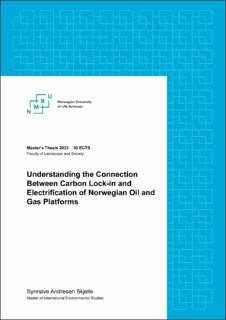| dc.description.abstract | Fossil fuels are by far the largest contributor to climate change. The oil and gas (O&G) industry is deeply embedded in the Norwegian economy, as the production provides a large share of Norway’s revenue and jobs. At the same time, the sector accounts for a quarter of the country’s total emissions. Hence, Norway finds itself in carbon lock-in, a concept that describes a state of path-dependence related to fossil fuels. Therefore, suggestions to phase out O&G production are often seen as controversial. However, the country has committed to ambitious emission reduction targets, and emission reduction within the O&G industry is essential to achieve them. The industry itself has proposed electrification of O&G platforms as the primary solution to reduce emissions. However, wide disagreement exists on the effects of electrification, and the literature lacks studies on how electrification will impact carbon lock-in. Avoiding systems that intensify or contribute to carbon lock-in is essential, as carbon lock-in is incompatible with a sustainable, low-carbon future.
Hence, this thesis seeks to fill this knowledge gap and examine how electrification of O&G platforms in Norway may contribute to carbon lock-in. Nine qualitative semi-structured interviews were conducted with informants holding different central positions in the debate on electrification. The data were analysed by identifying processes and traits of three different categories of carbon lock-in from Seto et al. (2016)’s framework: Technological and infrastructural, institutional and behavioural carbon lock-in.
The findings suggest that electrification will contribute to all three carbon-lock-in types. However, the extent of technological and infrastructural lock-in is seen to differ with electricity from land and electricity from offshore wind. Electrification with offshore wind is found to be less likely to contribute to technological carbon lock-in, as it allows for more flexibility and less asset specificity. Suggestions for future studies are to look into the carbon lock-in effects of other alternatives to electrification, such as carbon capture and storage and energy efficiency, and compare them to the findings of this study. That will provide a better knowledge base for policy-making on the future of the O&G industry. | |
